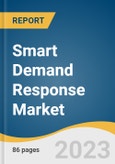The global smart demand response market size is expected to reach USD 88.79 billion by 2030, registering a CAGR of 17.4%.
Increasing grid deployment is expected to favorably impact market growth. Demand response plays an important role in electric grid operation by reducing electricity usage during peak hours.
Introduction of grid technologies is expected to open avenues for the traditional energy infrastructure vendors. Smart grids when coupled with metering systems; provide information on real time consumption to the customers as well as suppliers.
Spread of ubiquitous wireless networks as well as internet access, along with the growing level of intelligence built into HVAC systems, industrial controls, lighting networks and varied other big building loads is expected to drive the automated DR market.
Increasing grid deployment is expected to favorably impact market growth. Demand response plays an important role in electric grid operation by reducing electricity usage during peak hours.
Introduction of grid technologies is expected to open avenues for the traditional energy infrastructure vendors. Smart grids when coupled with metering systems; provide information on real time consumption to the customers as well as suppliers.
Spread of ubiquitous wireless networks as well as internet access, along with the growing level of intelligence built into HVAC systems, industrial controls, lighting networks and varied other big building loads is expected to drive the automated DR market.
Smart Demand Response Market Report Highlights
- Residential segment is poised to grow at a CAGR higher than the global average, which is a direct consequence of financial incentives and rebates offered by utilities to domestic customers to persuade them in the participation of several direct load control programs. The participation of smart buildings in DR programs to protect electrical grids for the duration of peak energy demand is expected to reduce loads during high-cost periods, thereby reducing bills.
- Industrial applications contributed to over 52.0% of the revenue in 2022; this large share can be attributed to DR programs offered by several utilities for maximizing power utilization through adoption of high efficiency variable speed drives and motors. Industrial customers are also encouraged to participate in such programs on account of lucrative financial incentives offered to them.
- Asia Pacific is expected to register the highest CAGR of 21.0% over the forecast period. It can be attributed to the growing adoption of smart meters in the region.
- The market is highly fragmented, with no particular company occupying a majority of the revenue share. The industry is characterized by companies having a strong hold over a particular region with little or no influence globally. However, through mergers & acquisitions, key participants have started expanding globally. Upcoming smart grid projects in countries such as Australia, India, China, and Japan have attracted prominent players in these regions.
Table of Contents
Chapter 1. Methodology and Scope
Chapter 2. Executive Summary
Chapter 3. Smart Demand Response Market Variables, Trends & Scope
Chapter 4. Smart Demand Response Market: Application Estimates & Trend Analysis
Chapter 5. Smart Demand Response Market: Regional Estimates & Trend Analysis
Chapter 6. Competitive Landscape
List of Tables
List of Figures
Companies Mentioned
- ABB
- Eaton
- Enel X S.r.l.
- General Electric
- Honeywell International Inc.
- Johnson Controls
- Oracle Energy and Water
- Siemens
- Schneider Electric
- Itron Inc.
Methodology

LOADING...
Table Information
| Report Attribute | Details |
|---|---|
| No. of Pages | 86 |
| Published | October 2023 |
| Forecast Period | 2022 - 2030 |
| Estimated Market Value ( USD | $ 23.81 Billion |
| Forecasted Market Value ( USD | $ 88.79 Billion |
| Compound Annual Growth Rate | 17.4% |
| Regions Covered | Global |
| No. of Companies Mentioned | 10 |








